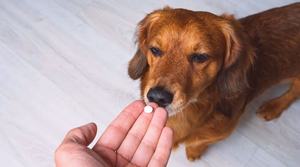
Reviewed & Fact-Checked by
Dr. Paula Simons
Veterinarian (DVM)
Learn more about our Veterinary Review Board »
Every pet parent wants to ensure that their pup is as healthy and happy as possible, and any signs of illness or distress are as upsetting for both them and their pet.
Becoming a little more informed about common conditions that affect dogs - and perhaps your breed specifically, can be very helpful, as should things seem to begin to 'go wrong' you will be better equipped to take the right action.
Here we will take a look at a disease of the eye commonly seen in dogs: Progressive retinal atrophy, or PRA for short.
What Is Progressive Retinal Atrophy?
The term atrophy, in general, refers to the deterioration or wasting of a body part, and in this case, it refers to the deterioration of the retinas.
A dog's eye, like the human eye, is made up of several different components, each of which serves a different purpose.
The retina is a thin layer of tissue that sits at the back of the eye and receives focused light from the lens. That light is then converted, via a series of photoreceptor cells in the retina known as cones and rods, into electrical signals sent to the brain.
In the brain, where they are processed and 'returned' as images.
When PRA begins to set in, as the name suggests, the retina begins to atrophy and the number of cones and rods it contains begins to decrease and fails to replenish as it should.
This leads to decreased visual abilities and eventually to blindness.
Different Types of Progressive Retinal Atrophy
Progressive retinal atrophy cases in dogs can usually be classified into two basic types.
Early onset PRA is commonly found in young puppies whose retinal photoreceptors develop abnormally from birth.
The late form (retinal dysplasia) is usually diagnosed in adult dogs between the ages of two and five, and occasionally a little older. The late form is what we generally call PRA. Importantly, cataracts can also occur with PRA.
What Causes PRA in Dogs?
For the most part, PRA is a genetic, inherited disease. It can affect any breed and is also seen in mixed breeds.
Just how the defective gene is inherited varies, but as a general rule once a pup is discovered to have the disease, and thus the gene, they should not be allowed to breed.
Which Dog Breeds are Susceptible to PRA?
As we mentioned, PRA can occur in any type of dog, but there are indeed some breeds that seem to be more predisposed to it than others.
Below lists some of these commonly affected breeds (this list is not exhaustive)
- Labradors
- Cavalier King Charles spaniels
- Springer spaniels
- Toy poodles
- American cocker spaniels
- Pembroke Welsh corgis
- Akitas
- Rottweilers
- Samoyeds
- Bedlington terriers
How Can I Tell If My Dog Has Progressive Retinal Atrophy?
Progressive retinal atrophy is in no way painful.
Dogs have great senses of smell and hearing, and do not rely on sight quite as much as humans do. For these reasons it can be hard to tell at first if there is really anything wrong with your dog's sight at all.
Often however, as the rods in the retina seem to deteriorate first, and faster than the cones, a dog will develop obvious night blindness. This can cause your dog to behave differently. Some dogs may appear to be more nervous moving around their home environment.
Pet parents concerned that their pup's vision is fading due to PRA may also notice that when the light shines directly on their pup's eye it becomes very reflective, and the pupils may dilate more than usual.
And while increased clumsiness and bumping into objects in their surroundings can simply be a sign of aging it can also indicate worsening vision as well.
How Is PRA Diagnosed?
It takes a full, expert examination by a veterinary ophthalmologist for PRA to be officially diagnosed.
As a starting, a general eye exam conducted by your family vet will often be the first place that a suspicion of the condition can be picked up, allowing the pup to be referred on for further testing.
Dog DNA tests are a great way for owners to discover their dog's genetic heritage and health predispositions.
Is there a Treatment for PRA?
Unfortunately, PRA has no known effective cure and there is no real way to treat it medically.
As it is the result of deterioration of bodily resources that cannot be replaced the eventual outcome of PRA will almost certainly be total blindness. This can occur over a timeframe of 1-2 years.
There is some thought that certain antioxidant vitamins and naturally occurring amino acids like those found in the Omega 3 fatty acids family may preserve eye health, but nothing has been found that could be considered conclusive.
However, as these substances do no harm and can be beneficial, giving them to your pup is perhaps not a bad idea.
Although there is no cure, or effective treatment for PRA the diagnosis may seem bleak, especially as most pups do develop total blindness within a year or two after the onset.
However, dogs deal with a loss of vision far better than humans. They can get do well by relying on their other senses, especially their sense of smell.
With a few lifestyle changes, and extra vigilance on the part of their pet parents, pups living with PRA can still lead very happy and productive lives.
For more useful tips and suggestions for living with a blind dog, check out this article at Veterinary Vision.
For more detailed information about PRA in dogs, check out this article at Veterinary Partner.



